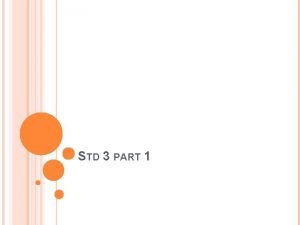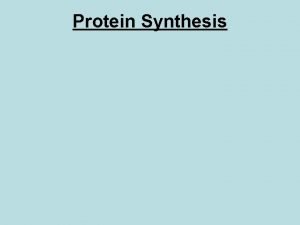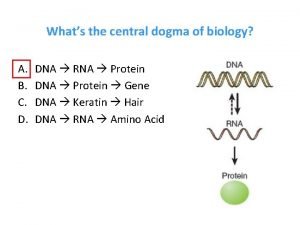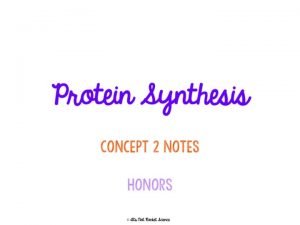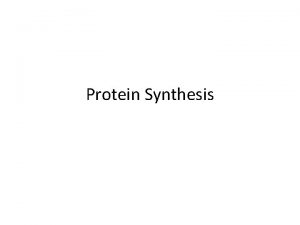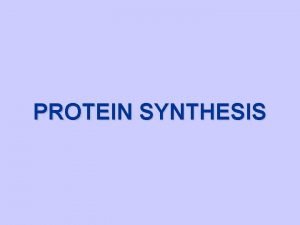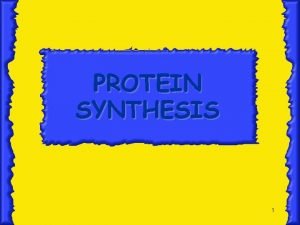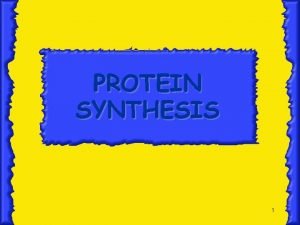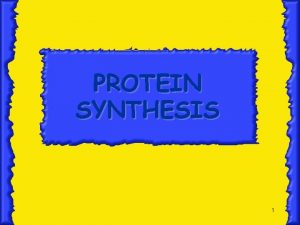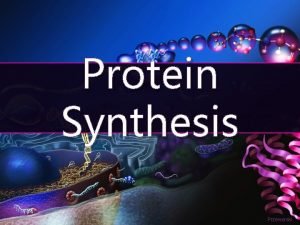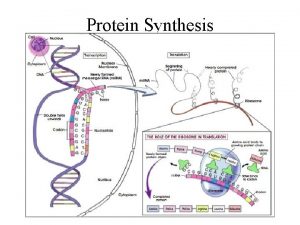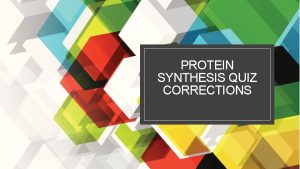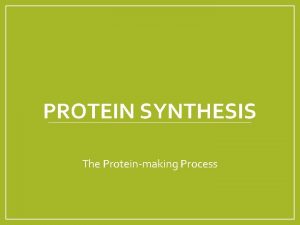Protein Synthesis The process of reading the instructions














- Slides: 14


Protein Synthesis • The process of reading the instructions in the DNA to make a protein. Central Dogma of Genetics • DNA = instructions and is in the nucleus and can’t leave • But proteins are made in ribosomes • So protein synthesis takes 2 steps: DNA transcription RNA translation protein

Remember Proteins? ? • Proteins are the most versatile macromolecules in living systems and serve crucial functions in essentially all biological processes such as: - Function as catalysts Transport and store other molecules such as oxygen Provide mechanical support and immune protection Generate movement Transmit nerve impulses Control growth and differentiation. • #proteinsmatter

Three Essential Types of RNA • m. RNA (messenger): copies instructions in DNA and carries these to the ribosomes in the cytoplasm • t. RNA (transfer): carries amino acids to the ribosome and m. RNA • r. RNA (ribosomal): composes the ribosome

TRANSCRIPTION Purpose: Carry the code/instructions out of the nucleus (Remember: DNA never leaves the nucleus, and proteins are made in the cytoplasm by ribosomes. ) Location: Nucleus Starts with: DNA Ends with: m. RNA

TRANSCRIPTION Process: 1. RNA Polymerase binds to the DNA promoter where transcription is to begin and unzips the gene that needs to be copied. (looks for “TATA box” as a signal) 2. RNA Polymerase uses complementary base-pairing rules to match RNA nucleotides with the exposed DNA nucleotides (Remember: RNA has uracil instead of thymine, so A binds with U) 3. Release the completed m. RNA molecule 4. DNA zips back up and the m. RNA leave the nucleus and enters the cytoplasm

Transcription: DNA is copied into a complementary strand of m. RNA 3’ RNA is made in the 5’-3’ direction The DNA template read in the 3’-5’ direction 5’ 3’ 5’ DNA 3’ 5’ 5’ 5’ 3’ 3’ m. RNA DNA m. RNA

Transcription – Try it! • DNA sequence (template): 3’ TACGCTAGTACGATT 5’ • m. RNA sequence: 5’ AUGCGAUCAUGCUAA 3’

Translation Vocabulary Genetic Code: code of instructions for how to make proteins Codon: a set of 3 nucleotides on the m. RNA (messenger) t. RNA (transfer) Amino acid – monomer (building block) Anticodon: “complementary” 3 for making proteins, held nucleotides on together by t. RNA peptide bonds

TRANSLATION Purpose: Read/follow the instructions carried on the m. RNA to make a protein Location: Cytoplasm / Ribosome Starts with: m. RNA Ends with: Protein

TRANSLATION Process: 1. m. RNA attaches to the small subunit of the ribosome 2. Ribosome reads the m. RNA codons (3 m. RNA nucleotides – like a triplet) ALWAYS in the 5’ to 3’ direction; starting at codon AUG. 3. t. RNA (transfer RNA) molecules act like taxis to pick up and drop off the amino acids that match with the current codon being read off the m. RNA. 4. t. RNA’s continue to drop off amino acids, and the ribosome binds the amino acids together with peptide bonds 5. When the “stop codon” is reached, the ribosome releases the completed protein.

Translation: interpreting the RNA message into a protein.

The Genetic Code

Transcription and Translation: Try it! • DNA sequence (template): 3’ TACGCTAGTACGATT 5’ • m. RNA sequence: 5’ AUGCGAUCAUGCUAA 3’ • Codons: AUG CGA UCA UGC UAA • Amino Acids: Met – Arg – Ser – Cys – stop
 Similarities between dna and rna
Similarities between dna and rna Which best summarizes the process of protein synthesis?
Which best summarizes the process of protein synthesis? Process of protein synthesis
Process of protein synthesis Pre reading while reading and post reading activities
Pre reading while reading and post reading activities Totipotent cell
Totipotent cell Section 12 3 rna and protein synthesis answers
Section 12 3 rna and protein synthesis answers Order of bases in dna
Order of bases in dna Protein synthesis restaurant analogy
Protein synthesis restaurant analogy Translation
Translation Protein synthesis bbc bitesize
Protein synthesis bbc bitesize 4 steps of protein synthesis
4 steps of protein synthesis Cookie monster analogy
Cookie monster analogy Whats translation in biology
Whats translation in biology Transfer rna
Transfer rna Protein synthesis
Protein synthesis

